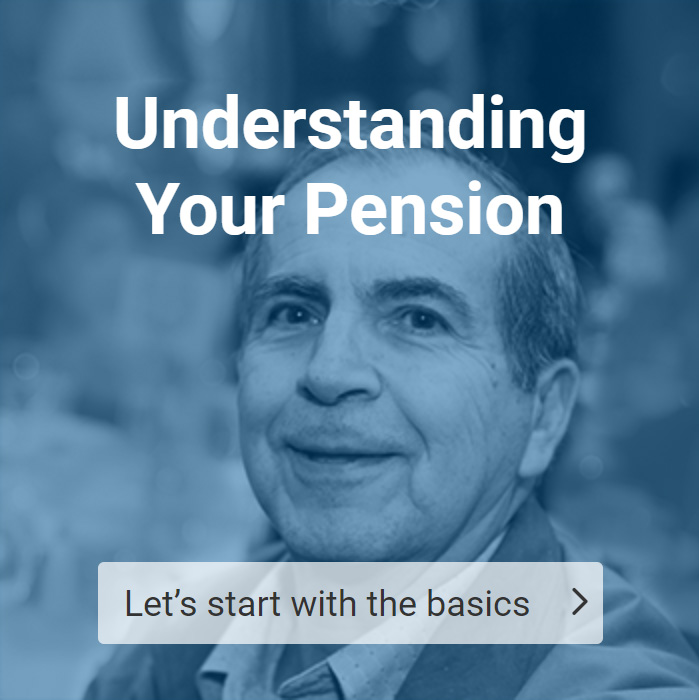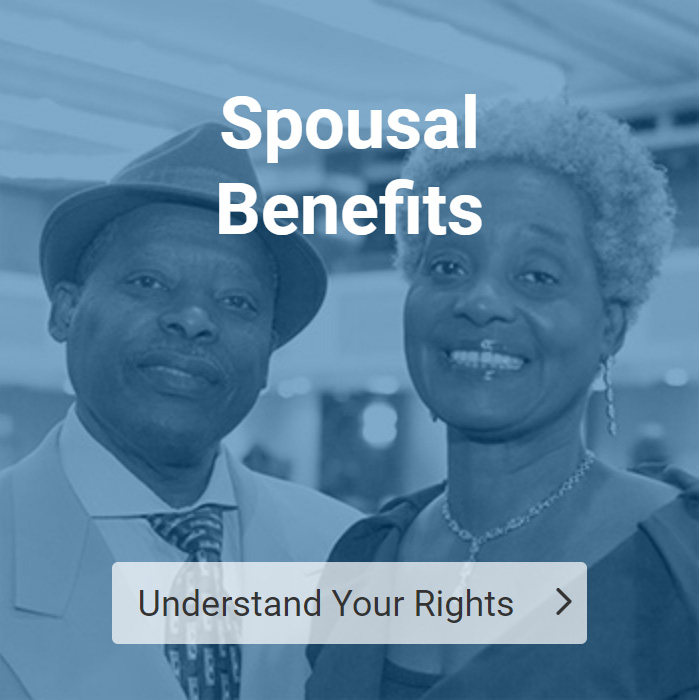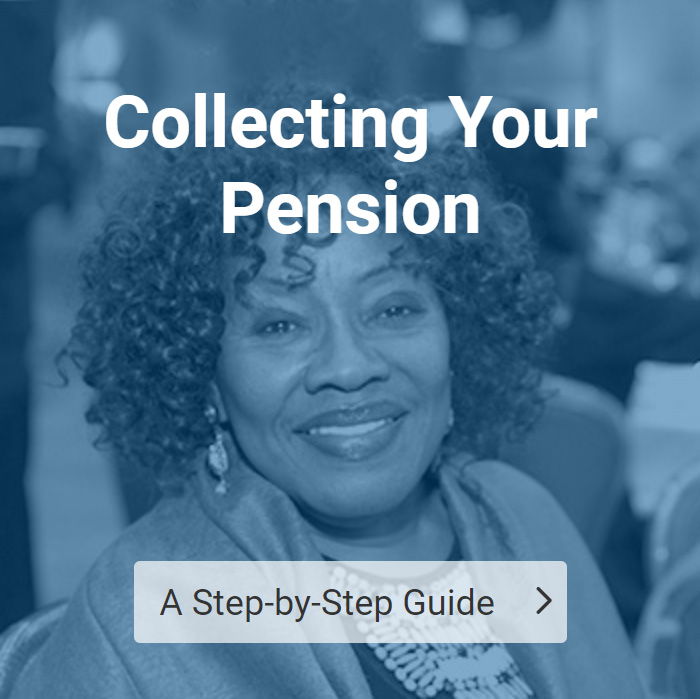Collecting Your Pension as a National Benefit Fund Member
Types of Pensions
Q: When can I start collecting my pension?
A: There are three types of pensions available under the pension plan:
1. Collecting a Full (“Normal”) Pension
If you are 65 or older, you can retire and receive a Full (“Normal”) Retirement Pension, as long as you have at least five years of credited service and/or vesting service.
If you are 62.5 and have at least 25 years of credited service and/or vesting service at the time you leave covered employment, you can retire and receive an Unreduced Early Retirement Pension, at the same amount you would have received when retiring at age 65.*
When you retire, you may be eligible for retiree health benefits.
If you stop working between 55 and 64, but wait until you are age 65 to start receiving your pension, you can still receive a Full (“Normal”) Retirement Pension because you delayed collecting it.
*If you were born before July 1, 1959, you can collect a full pension at 62 with 20 years of credited service and/or vesting service.
2. Collecting a Reduced Early Retirement Pension
If you are between 55 and 64, and have at least five years of credited service and/or vesting service, you do not have to wait until age 65 to collect your pension. You can choose to receive a Reduced Early Retirement Pension instead. However, your pension amount will be lower, since age 65 is considered the “normal” retirement age. Your benefits will be reduced according to an actuarial table that varies by your age at retirement, up to 9% each year.
3. Collecting a Disability Pension
You qualify for a Disability Pension benefit if all of the following are true:
- You are vested;
- You are approved for Social Security Disability; and
- You are totally and permanently disabled as a result of a condition that arose while you were still in covered employment and your employment ended as a result of that condition.
When you reach age 65, your Disability Pension benefit stops and the Pension Fund will send you an application for a (“Normal”) Retirement Pension.
Q: What is my pension based on?
A: We use this basic formula to calculate your pension:
Average Final Pay × How Long You Worked × Pension Multiplier = Your Pension
If you were first hired in a bargaining unit position before August 1, 2009, the Pension Fund looks at the last 10 years you worked and selects the five years in a row in which you earned the highest Regular Pay. The Fund averages those five years of Regular Pay, and this amount is considered your “Average Final Pay.” If you were first hired in a bargaining unit position on or after August 1, 2009, the Pension Fund looks at the last 10 years you worked, and your “Final Average Pay” is the average of your Regular Pay for those 10 years.
2. How Long You Worked
The number of months and years you worked* for a contributing employer(s) in a bargaining unit position.
*If you were hired on or after October 1, 2018, you will have a one-year delay before earning service credit. This will not affect Vesting Credit and does not apply to existing members who change jobs after that date.
3. Multiplier
The multiplier is 1.85% if your first hour of Credited Future Service was before August 1, 2009, and your last hour of Credited Future Service was after April 1, 2005. The multiplier is 1.60% if your first hour of Credited Future Service was on or after August 1, 2009. For multipliers prior to April 1, 2005, see your Summary Plan Description (SPD) for more detailed information.
Q: Can I continue to work part time after I retire?
A: It depends. You cannot collect your pension benefit while you are still working in “Disqualifying Employment.” Work is considered Disqualifying Employment if you:
- Work more than 40 hours per month;
- Work in the healthcare or human services industry or a related industry (including, but not limited to, hospitals, nursing and convalescent homes, drug stores, laboratories, medical schools and universities);
- Work using skills applicable to your previous employment in the healthcare or human services industry or a related industry; and
- Work in a state in which contributions to the Pension Fund were made or were required to be made.
If you work in Disqualifying Employment after your 65th birthday, you will not receive your pension benefit until your Disqualifying Employment stops. If you leave Disqualifying Employment, you should contact the Fund so that we can begin your benefits.
If you are actively working on the April 1st following the calendar year in which you turned 70½, you will have the option to start collecting your pension — even if you continue to work — on April 1st of the calendar year following the calendar year in which you reach age 70½. If you delay the start of your pension, you will continue to accrue pension credits. When you stop working, you are required to begin collecting your pension (in no event, no later than April 1st of the following year). You must complete and return your application and Election of Payment Option & Beneficiary Designation Form to the Fund. If we do not receive your completed forms by the date that you must begin collecting your pension, we will automatically make the default method of distribution payment under the pension plan, which is a life annuity if you are single, or a 50% Qualified Joint and Survivor Annuity if you are married.
If you are not actively working on the April 1st following the calendar year in which you turned 70½, you are required to begin collecting your pension.
*Credited Past Service is not provided after August 1, 2009, except under limited circumstances.
A Step-by-Step Guide to Retirement
The path to retirement will run more smoothly if you plan ahead. We’ve put together this step-by-step timeline to help you through the process:
THREE MONTHS BEFORE YOU TURN 65
Apply for Social Security and Medicare
Your 1199SEIU pension will supplement another important source of income available to you at age 65 — Social Security. And, if you are eligible for retiree health benefits through the 1199SEIU National Benefit Fund, your health benefits will be coordinated with Medicare. It’s important to apply for both of these benefits when you become eligible, and consider them in your retirement planning.
You can apply online at www.SSA.gov or contact Social Security/Medicare by calling (800) MEDICARE (633-4227).
SIX MONTHS BEFORE YOU RETIRE
Request and File a Pension Application
The first step toward retirement is filling out your pension application. This application, along with the required documentation, is the only document that can set your retirement in motion.
Required Documentation
There’s no getting around the fact that the retirement process has its share of paperwork. This planner can make it easier for you to gather the documentation you will need. Use this checklist to keep track of the information you have and the information you may need to track down.
- Citizenship/Proof of Age. Proof of citizenship for you and your spouse/beneficiary: birth certificate, naturalization papers, passport, resident alien card or enhanced driver license
- Government-issued marriage certificate, if married
- Death certificate for spouse, if applicable
- Divorce judgment, if divorced
- Unlocatable Spouse Affidavit (available from the Pension Fund), if you are separated from your spouse and are unaware of his or her whereabouts and address
- Recent pay stub
- Social Security cards for you and your spouse/beneficiary
AN INCOMPLETE APPLICATION WILL SLOW DOWN YOUR RETIREMENT PLANS
An application is considered incomplete if required documentation is missing or if the application is not signed. The Pension Fund cannot process your application if it is incomplete.
Your pension will be processed as soon as administratively possible, once the Pension Fund has your completed pension application. Keep in mind that this will take time. The Pension Fund must collect information from different sources, such as your employer(s) and the Social Security Administration (if applicable), so processing depends on how quickly we receive that information. You can do your part to speed up the process by submitting all required documentation when we ask for it.
Notify Your Employer
You should advise your employer of your retirement date as soon as possible. You may do this by submitting a Notice of Retirement.
Receive an Explanation of Benefits Letter and Retirement Information from the Pension Fund
When we’ve received your signed application or request for an application, you will then receive an Explanation of Benefits letter, along with retirement and supplemental health benefit information. Your Explanation of Benefits letter will contain different monthly pension amounts. This is because there are several pension payment options for you to choose from. We have Pension Counselors on staff to help you make the choice that’s right for you.
AT LEAST THREE MONTHS BEFORE YOU RETIRE
Make an Appointment with a Pension Counselor
To help members make the most informed pension benefit choices, we strongly encourage you and your spouse to meet with a Pension Counselor. You should make your appointment at least three months before you retire, and up to six months in advance, if possible. Our pension experts can guide you and your spouse through the process and answer any questions. Your Pension Counselor will also help you fill out all your pension paperwork.
Pension Counseling Hours
Appointments are scheduled for approximately one hour, with priority given to those members who are closest to retirement. Call the Pension Fund at (646) 473-8666 to schedule an appointment. If you live outside New York City, please call (800) 892-2557. You can also visit a walk-in Pension Member Services Department; centers are located in all five boroughs of New York City, Hicksville and White Plains.
Choose Your Pension Option and Beneficiary
You will receive an Election of Payment Option & Beneficiary Designation Form when you receive your Explanation of Benefits letter. Your Pension Counselor will explain your options and help you fill out the form at your appointment. On this form, you will make three very important retirement decisions about:
- Your pension option, which will affect the estimated amount you and your spouse/beneficiary will receive each month;
- The person who will receive your pension benefits upon your death (known as your “beneficiary” or “beneficiaries” if there is more than one person); and
- How you would like to receive retroactive payment if the Pension Fund is delayed in starting your pension
Choose Actuarial or Lump-sum Payment for Retroactive Payments
Under certain circumstances, the Pension Fund may not be able to begin your pension payments on the date you choose; for example, if we are still collecting information. If this happens, you have two choices for receiving the money owed to you retroactively from your desired pension start date. You must choose one of the following:
- Actuarial Pension Payment: Receive a part of the reimbursement in each of your regular monthly pension payments over the life of your pension.
- Retroactive Lump-sum Payment: Receive the reimbursement in one full payment. In addition to your monthly payment, you will receive one make-up check for the money owed to you.
If you are married, your spouse must consent to your payment choice where it is indicated on the Election of Payment Option & Beneficiary Designation Form. This represents the notarized consent of your spouse.
File a Tax Form W-4P
Tax Withholding
Your 1199SEIU Health Care Employees Pension Fund benefit is taxable by the federal and state government as ordinary income. Pension payments are subject to federal income tax withholding, unless the pensioner elects not to have withholding apply. The W-4P federal withholding form, along with the Fund’s Notice of Withholding on Periodic Pension Payment, are included in this packet.
The W-4P federal withholding form must be completed and either submitted with your pension application, or mailed or faxed to the Pension Fund.
Pension Fund fax: (646) 473-8746
Pension Fund address:
1199SEIU Health Care Employees Pension Fund
498 Seventh Avenue
New York, NY 10018
Filing Your Tax Return
Each year you will receive a Form 1099-R from the Pension Fund to file with your tax return, as required by law; a copy is also sent to the IRS. If you wish to change your federal withholding amount, you must send the Fund a new W-4P withholding form. You may change your withholding amount at any time.
AT LEAST ONE MONTH BEFORE YOU RETIRE
File a Direct Electronic Deposit Authorization Form
You can have your pension check automatically credited to your savings or checking account on the first day of every month, so you don’t have to worry about lost or stolen mail or long lines at the bank.
Direct Electronic Deposit Authorization Form
Because your account number, account type and routing number must be accurately entered, we encourage you to take the form to your bank to verify the information or provide us with a voided check. It takes approximately four weeks for direct electronic deposit to be put into effect.
You may move your account to another bank at any time. All you have to do is notify the Pension Fund and complete a new Direct Electronic Deposit Authorization Form.



